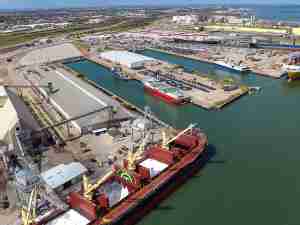Fitch Ratings has assigned a 'AA' rating to $172.5 million in senior lien Port of Long Beach Harbor revenue bonds series 2017A, 2017B, and 2017C, issued by the the City of Long Beach, CA. Fitch has also affirmed the 'AA' rating on $822.7 million in outstanding senior lien harbor revenue bonds and notes, and the 'AA-' rating on the outstanding, but yet to be issued, $325 million subordinate TIFIA loan. The Rating Outlook on all bonds is Stable.
KEY RATING DRIVERS
The ratings reflect the port's strong market position, with resilient revenues from long-term contractual guarantees that are sufficient to cover both the port's outstanding senior debt obligations and the subordinate TIFIA loan when issued. Going forward, contractual guarantees should continue to provide revenue stability as the port proceeds with borrowing for its sizable $3.0 billion long-term capital improvement plan (fiscal 2017 - 2026 CIP). This plan, while costly, will help ensure the port's competitive position going forward. Maintenance of strong financial metrics and considerable liquidity in line with management's guidelines of 2.0x minimum DSCRs and 600 days cash on hand are expected throughout execution of the CIP in order to support the port's ratings. The one-notch differential on the TIFIA loan reflects its subordinate claim on revenues.
Strong Market Position: (Revenue Risk - Volume: Stronger)
The Port of Long Beach is the nation's second largest container port, located on the west coast. Together with the neighboring Port of Los Angeles, it constitutes the San Pedro Bay Port Complex -- the seventh largest port complex in the world. Fiscal 2016 20-foot equivalent units (TEUs) were 6.94 million, a 2.0% decrease over 2015 that reflects the departure of two large shipping lines (Hanjin due to bankruptcy and CMA CGM due to moving to Port of Los Angeles). The port's ability to handle larger ships, sizable local market share, and strong representation across the newest shipping alliances position the port favorably even as the shipping industry continues to see consolidation. Fitch also views port moves toward chassis management agreements as a positive development in alleviating port congestion.
Resilient Revenues Through Volatility: (Revenue Risk - Price: Stronger)
With a large majority of operating revenues coming from the container business (76% of operating revenues in fiscal 2016), the port is exposed to fluctuations in international trade and growing competitive pressures, which can lead to volume volatility. This has been especially true in 2016 and 2017 with the bankruptcy of Hanjin and the realignment of container shippers into new alliances resulting in volume fluctuations for Port of Long Beach and other ports worldwide. However, the port's revenues have proven to be largely insulated from trade-related revenue volatility due to the high percentage of long-term guaranteed contracts in place with most tenants. Fitch notes agreements have been honoured even through the Hanjin bankruptcy. Minimum guarantees accounted for 87% of operating revenues in fiscal 2016, and this share is likely to increase in the medium term as higher guarantees come online in connection with the completion of the Middle Harbor Redevelopment.
Modern Facilities, Sizable Capital Program: (Infrastructure Development/Renewal: Midrange)
While the port benefits from modern facilities, the port's capital program through 2026 is sizable at $3.0 billion, and additional borrowing of $1.16 billion is anticipated (86% anticipated in the next four years). The scope and cost of the CIP keep the Infrastructure score at Midrange at present, though this may migrate upwards as large components of the CIP are completed. Careful management of the plan's scope and cost relative to business demand to maintain the port's strong financial profile is important to rating maintenance. Fitch notes that projects are proceeding well thus far.
Fixed Rate, Amortizing Debt: (Debt Structure (Sr): Stronger / Debt Structure (Sub): Midrange)
Fitch views POLB's Debt Structure as Stronger for the Senior Lien and Midrange for the Subordinate TIFIA loan. Senior bonds are all fixed rate and benefit from strong covenants, although Fitch notes future bonds are not structured to include a DSRF. The subordinate TIFIA loan is also fixed rate, and benefits from a fixed amortization profile, but has a junior claim to revenues. Fitch views positively the board's ordinance requiring maintenance of 2.0x DSCR (all-in) and 600 days cash on hand (DCOH), which serve to protect bondholders as additional leverage for the CIP is brought online.
Financial Profile: The port has a healthy balance sheet with a strong liquidity position, even as cash is used for the ongoing CIP. Liquidity for 2016 of $335 million represents 847 DCOH. Senior DSCR has remained near 3.0x since 2011, dipping slightly to 2.47x in 2016. DSCR is projected to remain at or above 1.9x in Fitch's rating case and downside scenarios. Port leverage for 2016 is low at 1.8x net debt/cash flow available for debt service (CFADS) on all obligations (includes TIFIA loan), though this is expected to rise to the 4.0x to 5.0x range as borrowing for the full capital plan is executed over the next five years.
Peer Group: The Port of Los Angeles ('AA'/Outlook Stable) is the closest peer to Long Beach, sharing the San Pedro Bay and access to the Alameda Corridor. Long Beach's liquidity compares favorably to Los Angeles', and current metrics are comparable, while Long Beach's capital plan going forward is more substantial than that of Los Angeles and requires substantial additional borrowing over the next five years. Port Houston (IDR 'AA'/Outlook Stable) is another comparable port, with access to tax revenues and comparable borrowing for its sizable CIP but lower guaranteed revenue.
RATING SENSITIVITIES
Future Developments That May, Individually or Collectively, Lead to Positive Rating Action:
- Given both the current rating level and the scope of the current capital plan, upward rating migration is not likely at this time.
Future Developments That May, Individually or Collectively, Lead to Negative Rating Action:
- Higher than anticipated volatility or a steady downward trend in port container volumes;
- Financial forecasts indicating metrics falling below management's policy of maintaining 2.0x DSCR and liquidity equivalent to 600 DCOH; and
- Upward revisions to the capital program or debt funding that could indicate weaker debt metrics or measurably reduce port liquidity.
TRANSACTION SUMMARY
The port is planning to issue $172.5 million of series 2017 harbor revenue bonds, including $103 million in AMT bonds (series 2017 A), $26.4 million in Green AMT bonds (series 2017B), and $43.1 million in non AMT bonds (series 2017C). Pricing is expected June 15. The bond proceeds, and other funds, will pay for capital expenditures incurred by the Port, refund all outstanding subordinate revolving obligations (currently $25 million drawn on $200 million line of credit facility), and cover the costs of issuance. The bonds will be fixed rate with a final maturity of 2047. The port will not be setting aside cash reserves for the new money 2017 bonds; Fitch notes the port's overall strong cash balances somewhat mitigate the lack of a cash funded reserve.
Performance Update
While container volumes at Long Beach have improved since the recession, 2016 saw declines due to unique events. In 2016, Long Beach was affected by the bankruptcy filing and resulting cargo reduction of Hanjin Shipping. Prior to this, Hanjin owned 54% of Total Terminals (TTI), operator of Pier T Container Terminal, which generated roughly 22% of port operating revenues in fiscal 2016. Under bankruptcy proceedings, Hanjin sold its interest in TTI to a subsidiary of Mediterranean Shipping Company (MSC) and Hyundai Merchant Marine. Due to the bankruptcy, cargo at Pier T fell 36.9% from September 2016 to the end of the calendar year; POLB's overall cargo throughput decreased by 7.7% in the same period. However, operating revenues only decreased by 0.17% on a year over year basis, and TTI continued to make all its guaranteed annual minimum payments to the port throughout the bankruptcy.
Despite a 2.0% decrease in TEUs for fiscal 2016, the overall TEU trend remains one of growth for the port, with the 2011 - 2016 CAGR at 2.0%. The first six months of fiscal 2017 have dropped a further 4.3%, largely reflecting Hanjin's filing for bankruptcy in August 2016, CMA CGM's departure for the Port of Los Angeles, and the resulting slowdown in containers passing through Long Beach. However, first quarter results for calendar 2017 have seen a steady increase in TEU volumes, and several new services are now calling the Port (SM Line, HMM and joint-service by COSCO/PIL/Wan Hai). TTI continues to perform above minimum guaranteed levels. As a result, management expects that fiscal 2017 revenues will perform in line with budget.
Declines and recoveries in volumes have had limited impact on the port's rating, largely due to the revenue stabilizing nature of the port's long-term leases with its largest tenants. These long-term lease contracts collectively contain minimum payment provisions that are more than sufficient to cover both the port's outstanding senior debt obligations and the future subordinate TIFIA loan, if issued (covering all obligations at 1.88x on a net basis in 2016, and continuing to cover at 1.1x or higher through 2021). Even during periods of volume fluctuations (previously due to labor unrest and most recently due to carrier departures), minimum guarantees have been honored, and management indicates that key tenants desire to maintain long-term operations at the port. This is demonstrated by Orient Overseas Container Line (OOCL's) 40-year lease for the Middle Harbor project. Going forward, contractual guarantees are expected to increase as the Middle Harbor project comes online (Phase 1 of the project now operational, Phase 2 to be completed in 2017). Guarantees will continue to provide revenue stability as the port proceeds with expected future borrowing for its sizable long-term CIP.
Historically, the port has maintained high DSCRs, with net coverage on all obligations in the 3.0x range both prior to the recession and since fiscal 2011. Coverage remains well above the rate covenant of 1.25x, at 2.47x in 2016. Cash reserves are extremely robust with $335 million in unrestricted funds, which translates to 847 DCOH. The port manages to a minimum of 2.0x net coverage and 600 DCOH, per an ordinance adopted by the Board of Harbor Commissioners in October 2011. Fitch views this policy as providing liquidity stability for bondholders, and sees continued management to these levels as important to maintenance of credit quality as the port proceeds with borrowing for its capital program. Fitch notes that potential contingent liabilities to ACTA for debt payments are legally subordinate to port revenue bonds. Due to ACTA's recent restructuring of its debt, no additional ACTA shortfall advance payments are expected during the forecast period.
Fitch Cases
Both San Pedro Bay ports are well-positioned in terms of portside and inter-modal infrastructure, allowing them to accommodate local and non-local shipments. However, with up to 65% of cargo destined for inland markets, competition for this cargo may increase as ports on both the East and West Coasts compete for discretionary cargo volumes. Under various scenarios that contemplate drops in cargo volumes, funding of the full capital plan with an additional $1 billion of debt obligations per management's projections and careful management of operating and capital expenditures, forecasted DSCR for both senior and subordinate TIFIA obligations are expected to remain at or above 2.0x in a base case scenario, which assumes modest average annual revenue growth of 3.5% through 2022 and expense growth of 4.4% over the same period. In this scenario, leverage rises to 3.39x, reflecting over 90% of the expected additional debt for the CIP.
Fitch's rating case contemplates the blended effect over five years of a 10% drop in cargo coupled with 7% drop in revenues, followed by 4.0% revenue recovery. Over the five-year forecast period this represents average annual revenue growth of 2.0%, coupled with expense growth of 4.9%. In this scenario, DSCRs for all obligations remain above 1.9x, and leverage reaches 3.85x by 2022 including CIP debt. Should volume stagnate or should the port fail to manage its expense profile prudently, the port may need to delay or defer certain elements of the capital program in order to maintain these coverage levels. Failure to maintain coverage above 2.0x or liquidity above 600 DCOH in keeping with the port's debt ordinance will jeopardize the current rating.
SECURITY
The senior lien bonds are secured by a pledge of and lien upon gross revenues. The Transportation Infrastructure Finance and Innovation Act (TIFIA) loan is secured by a lien on the port's subordinate revenues, or gross revenues remaining after the payment of debt service on senior bonds and the funding of any debt service reserve funds established










